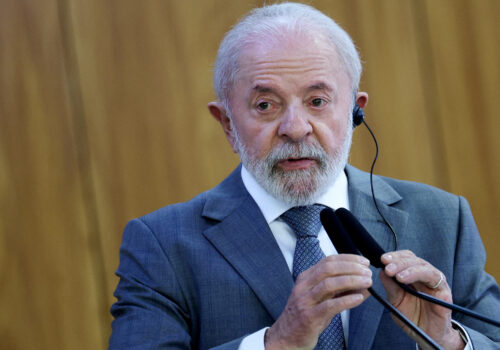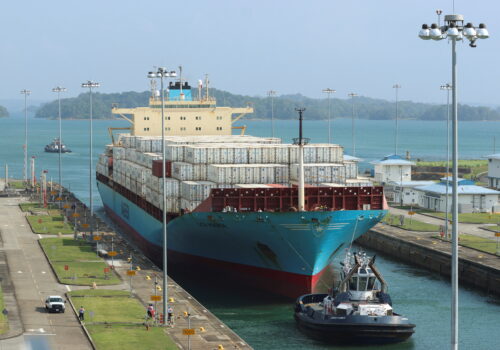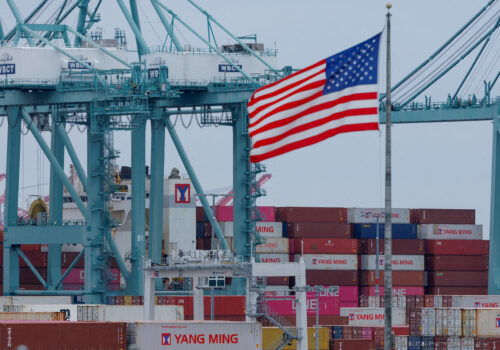Dispatch from Panama City: What’s behind the new optimism in US-Panama relations?
PANAMA CITY—It’s amazing what a difference a few months can make. In January, the United States’ relationship with Panama was strained. During his inaugural address, President Donald Trump made headlines around the world when he said that the United States was “taking back” the Panama Canal. Panama was, in fact, the first foreign country that the US president spoke of at any real length, and it appeared at the time that bilateral relations were only headed further south.
Fast forward to today, however, and Trump’s initial attention has transformed the bilateral relationship into one of the most strategically important in the hemisphere. In the first six months of the second Trump administration, Panama has welcomed a slew of high-level US officials, including Secretary Marco Rubio, who traveled to the country in his first foreign trip in office. It was only the second time in US history that a secretary of state chose Central America as their first stop abroad.
This past week, I traveled to Panama along with Jason Marczak, the vice president and senior director at the Atlantic Council’s Adrienne Arsht Latin America Center. It was the Center’s third visit in eight months. Just hours before we landed, major news broke: Panama was officially removed from the European Union’s anti–money laundering and counterterrorism “gray list.” This step is significant for several reasons: It creates smoother cross-border transactions, increases investor confidence, and represents a symbolic green light for US companies with a desire to deepen ties in the country.
The European Union has officially removed Panama from its list of high-risk countries for money laundering and terrorist financing.
— Arsht Latin America Center & Caribbean Initiative (@ACLatAm) July 10, 2025
AALAC’s Vice President and Senior Director, @jmarczak , and Central America Lead, @MariaBozmoski, are on the ground with what this means for… pic.twitter.com/PQSaffg0Oa
This news is likely to accelerate the growing momentum in Panama’s economy that we sensed in meetings with private sector leaders from the hospitality, pharmaceutical, and industrial sectors. Business leaders in these industries spoke to us about a surge in tourism, rising investor interest, and opportunities that are materializing.
There is also an important new player on the ground. US Ambassador Kevin Marino Cabrera, a recent Trump appointee and Miami native who has been at his post for a little over two months. He is only one of two newly appointed Trump ambassadors in the region. (The other is Ambassador Ron Johnson in Mexico, the United States’ largest trading partner.) Cabrera has quickly become a major conduit for US policy and private-sector dialogue. His presence is likely to continue to strengthen the United States’ relationship with Panama.
Overall, two themes stood out in our discussions with Panamanian officials and business leaders.
- In February, Panama exited from China’s Belt and Road Initiative (BRI), after becoming the first Latin American country to join back in 2017. Many people we spoke with applauded this decision, saying the country’s adherence to the BRI was rather pointless and stale. It had not translated into any major wins for Panama. Some people we spoke with said that Chinese investment in Panama has been minimal—$1.4 billion in 2023, versus $4.5 billion from the United States—and that the politics and headache of belonging to the BRI were not worth it. Similarly, several Panamanians spoke about how their fellow citizens hold a strong affinity for the United States, so it made little sense for Panama to side so directly with the US rival.
- The European Commission delisting Panama opens new doors for US financial institutions and investors, many of whom have been awaiting a green light to expand their operations here. There are big infrastructure plans on the horizon, including a potential major liquefied natural gas pipeline that would go from one coast to the other, which could help alleviate canal congestion. The US Congress and relevant agencies should now work to make sure the reauthorization of the US International Development Finance Corporation (DFC) stays on track. That’s because the DFC, which is responsible for advancing economic engagement in emerging markets to advance national security interests, can help US companies compete. Should the DFC’s authorization lapse, US companies would not be able to rely on the institution for political risk insurance or technical aid, which could translate into major commercial, strategic, and security losses down the road.
To be sure, challenges remain for the country of 4.5 million. Unrest and dissatisfaction have been brewing since the COVID-19 pandemic, during which Panama had one of the region’s most restrictive sets of guidelines. And unrest continues to bubble up around issues of economic insecurity. Just last month, for example, protesters called for the Cobre Panama copper mine to reopen because economic activity in surrounding communities has ground to a halt. The mine is responsible for some forty thousand direct and indirect jobs, but it was shuttered by the government in 2023 after the contract for First Quantum, the mine’s Canadian parent company, was ruled unconstitutional. The government seems to be working quietly on next steps for the mine, whether it be via First Quantum or otherwise. If Panama reopens the bidding for the operation of the mine, a US-led consortium could submit a competitive bid and build up the Western Hemisphere supply chain for this important mineral.
The uncertainty around the copper mine comes on top of the news out of Bocas del Toro, where the Chiquita banana company decided to leave, and over 6,500 workers are now without an income. It’s a stark reminder that governance, communication, and shared prosperity must go hand in hand.
The prospect of tariffs, too, is raising concerns. But since Panama has few exports, and since the United States enjoys its fifth-largest trade surplus with the country, potential tariffs do not seem to be particularly worrying here, even as Trump is threatening dozens of countries with rates well beyond its global 10 percent tariff. At the time of writing, Panama has not received any letters from the Trump administration threatening high tariff rates. Meanwhile, the upcoming review of the US-Panama trade promotion agreement later this fall will be an opportunity to modernize the deal.
While the excitement and momentum in Panama is palpable, so is the pressure to deliver. No side can take the relationship for granted or let it turn sour again. For the United States, the opportunity is clear: to support a reliable partner that is a main artery of global trade, regional stability, and geopolitical competition.
María Fernanda Bozmoski is director, impact and operations, and lead for Central America at the Atlantic Council’s Adrienne Arsht Latin America Center.
Further reading
Thu, Jul 10, 2025
Trump is threatening Brazil with a 50 percent tariff. How will Lula respond?
New Atlanticist By Ricardo Sennes, Valentina Sader
The large tariff on Brazilian imports to the United States is set to take effect August 1, unless the US president and his counterpart in Brasília can strike a deal.
Mon, Jan 27, 2025
Expert context: What’s going on with Trump and the Panama Canal?
New Atlanticist By
With US President Donald Trump focusing on the critical waterway early in his second term, Atlantic Council experts explain how the canal came about, why it matters today, and what to expect next.
Tue, Jun 17, 2025
What should Trump do next on trade? Optimize existing US trade agreements in Central and South America.
New Atlanticist By Enrique Millán-Mejía
The best way to foster sustainable growth for US exports to the region is to seek predictable rules of engagement with Western Hemisphere trading partners.
Image: A drone view shows the statue of Panama's late President Omar Torrijos and late U.S. President Jimmy Carter shaking hands in honour of the signing of the Panama Canal Treaty and the Neutrality Treaty, which sealed the U.S. handover of the waterway, standing in the Amador Causeway, in Panama City, Panama January 24, 2025. REUTERS/Enea Lebrun



